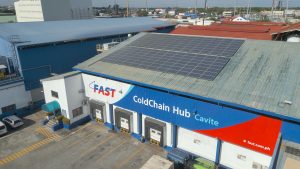
Businesses across various industries are increasingly recognizing the importance of reducing their carbon footprint and adopting eco-friendly practices. Warehousing, as a crucial part of the supply chain, plays a significant role in this endeavor.
The warehousing industry has traditionally been associated with high energy consumption, waste generation, and carbon emissions. However, with advancements in technology and a growing awareness of environmental issues, there are now innovative and practical solutions available to transform warehouses into sustainable, eco-friendly spaces:
- Embracing Renewable Energy
- Energy-Efficient Lighting Systems
- Optimizing Heating, Ventilation, and Air Conditioning (HVAC) Systems
- Sustainable Packaging and Materials
- Implementing Recycling and Waste Management Programs
By incorporating these five practices into your warehouse operations, you can make substantial progress in lowering your carbon footprint and promoting sustainability. Not only will these efforts contribute to a healthier planet, but they can also lead to cost savings, improved brand reputation, and increased customer loyalty.
Sustainable Warehousing
Sustainable warehousing refers to the practice of conducting warehouse operations in an environmentally responsible and resource-efficient manner, with the goal of minimizing the negative impact on the planet.
It involves adopting strategies and implementing measures that reduce energy consumption, waste generation, and carbon emissions, while promoting the efficient use of resources throughout the warehousing process.
It encompasses various aspects, including the design and construction of eco-friendly warehouse facilities, the implementation of energy-efficient technologies, the adoption of sustainable packaging materials, the promotion of recycling and waste management programs, and the utilization of renewable energy sources.
A sustainable warehouse also involves optimizing supply chain logistics to reduce transportation-related emissions and promoting sustainable practices among warehouse employees.
The key principles of sustainable warehousing revolve around reducing the environmental footprint of warehouse operations while maintaining efficiency and profitability. Sustainable warehousing aligns with broader sustainability goals and supports the transition towards a more sustainable and circular economy.
When businesses embrace sustainable warehousing practices, they can contribute to environmental conservation, improve their brand image, meet regulatory requirements, reduce operational costs through energy savings, enhance supply chain resilience, and attract environmentally conscious customers.
Sustainable Warehouse vs. General Warehouse Operations
General warehouse operations typically prioritize efficiency, productivity, and cost-effectiveness without placing significant emphasis on environmental considerations. While general warehouses aim to meet customer demands and optimize the flow of goods, they may not proactively address sustainability concerns such as energy consumption, waste generation, or carbon emissions.
On the other hand, sustainable warehousing goes beyond traditional warehouse practices by integrating environmentally friendly strategies into every aspect of operations. It aims to minimize the negative impact on the environment while maintaining efficiency and profitability.
The key difference between green warehouses and general warehouse operations lies in their approach toward environmental responsibility and resource efficiency.
Sustainable warehouses adopt a holistic approach that encompasses eco-conscious design, energy-efficient technologies, waste reduction and recycling, sustainable packaging, renewable energy sources that help in reducing greenhouse gas emissions, and responsible supply chain management. By prioritizing sustainability, sustainable warehouses actively contribute to mitigating climate change, conserving resources, and reducing ecological footprints.
It also takes into account the environmental impact of each decision, striving to reduce excess electricity consumption, minimize waste, and lower carbon emissions throughout the supply chain. It involves adopting innovative technologies, implementing best practices, and promoting a culture of sustainability among employees.
So while general warehouse operations focus primarily on efficiency and cost-effectiveness, a sustainable warehouse goes a step further by integrating environmental responsibility into all aspects of warehouse management, with the aim of reducing the overall ecological impact. They often strive to obtain eco-certifications, meet sustainability standards, and demonstrate their commitment to environmental stewardship.
Five Practices to Lower Your Warehouses’ Carbon Footprint
Join us as we explore five effective practices that can help you lower the carbon footprint of your warehouse operations. By implementing these strategies, you can not only contribute to environmental conservation but also improve the efficiency and profitability of your warehouse. So, without further ado, let’s dive into the details.
Embracing Renewable Energy
Embracing renewable energy is a highly effective approach for reducing the carbon footprint of warehouse operations. By transitioning to renewable energy sources, warehouses can significantly decrease their reliance on fossil fuels and contribute to the generation of clean electricity. One of the most common and accessible options for warehouses is the installation of solar panels.
Solar panels utilize the power of sunlight to convert it into solar energy. By harnessing this renewable source of energy, warehouses can generate clean and sustainable power on-site. Moreover, solar energy systems can provide a reliable and stable source of electricity for warehouse operations.
The installation of solar panels on the roof of a warehouse not only provides a dedicated space for solar energy generation but also utilizes an otherwise unused area. This helps maximize the energy production potential without requiring additional land or resources.
Earlier this year, FAST turned to solar energy technologies, with two of its logistics hubs integrating solar panels; one cold storage facility based in Cavite utilizes solar panels with a rooftop solar energy system of 503 kWp and 6GWh of renewable energy, while a solar-powered warehouse in Cabuyao, Laguna is equipped with a hybrid grid-connected/solar energy system.

It’s important to note that embracing renewable energy in warehouses, such as the use of solar panels, not only reduces greenhouse gas emissions but also offers long-term financial benefits. While the initial investment for opting to install solar panels or other renewable energy systems may be significant, warehouses can experience substantial energy cost savings over time.
Energy-Efficient Lighting Systems
Energy-efficient lighting systems play a crucial role in sustainable warehousing by reducing energy consumption, minimizing environmental impact, and optimizing operational efficiency. Traditional lighting fixtures, such as fluorescent or incandescent bulbs, are known for their energy inefficiency and high electricity consumption.
Upgrading to energy-efficient LED (Light-Emitting Diode) lighting systems offers significant benefits for warehouses. Compared to traditional lighting options, LED lights consume significantly less electricity to produce the same level of brightness. This energy-saving characteristic makes them an ideal choice for sustainable warehousing.
By switching to LED lighting, warehouses can experience substantial reductions in energy consumption and decreased carbon emissions. On average, they can last up to 50,000 hours or more, which is significantly longer than fluorescent or incandescent bulbs. This longevity translates to reduced maintenance costs and fewer replacement needs, resulting in additional savings for warehouse operations.
Optimizing Heating, Ventilation, and Air Conditioning (HVAC) Systems
Optimizing heating, ventilation, and air conditioning (HVAC) systems is a critical aspect of sustainable warehousing. While HVAC systems are essential for maintaining comfortable working conditions in warehouses, they can consume substantial amounts of energy if not properly managed. Warehouses can minimize energy wastage with energy-efficient practices, while still ensuring proper air quality and a comfortable environment for employees.
Warehouse layouts should be planned to ensure proper air circulation, allowing conditioned air to reach all areas efficiently. This can be achieved through strategic placement of vents, fans, or air diffusers for air quality improvement. By optimizing airflow, warehouses can achieve more uniform temperature control, reducing the reliance on HVAC systems and conserving energy.
Incorporating energy-efficient components into HVAC systems can also contribute to sustainability. For example, installing high-efficiency motors, variable speed drives, or energy recovery systems can reduce power bills and increase overall system efficiency. Energy recovery systems can capture and reuse waste heat or coolness generated by HVAC systems, reducing the need for additional energy inputs.
Sustainable Packaging and Materials
Sustainable packaging and materials play a crucial role in reducing waste generation and promoting environmentally responsible practices within warehouse operations. Warehouses handle large quantities of products that are often packaged in materials that can contribute to waste and environmental harm.
Choosing sustainable packaging materials is a key step toward reducing waste in warehouses. Traditional packaging materials, such as single-use plastics or non-recyclable materials, can contribute to pollution and resource depletion. By transitioning to sustainable alternatives, such as recycled or biodegradable packaging materials, warehouses can minimize their impact on the environment.
In addition to sustainable packaging materials and efficient inventory management, warehouses can also explore other sustainable practices related to packaging. Warehouses can also consider implementing returnable or reusable packaging systems, where appropriate, to reduce the need for single-use packaging materials.
Implementing Recycling and Waste Management Programs
Implementing recycling and waste management programs is a fundamental component of sustainable warehousing. These programs are designed to minimize waste generation, promote recycling, and divert waste from landfills. By adopting comprehensive waste management practices, warehouses can demonstrate their commitment to environmental stewardship and contribute to a circular economy.
To enhance waste diversion efforts, warehouses can also explore partnerships with local recycling facilities. Establishing relationships with recycling centers or waste management companies enables warehouses to efficiently process and recycle materials. These partnerships can involve regular pickups or drop-off arrangements to ensure that recyclable materials are handled properly and diverted from landfills.
In addition to traditional recycling programs, warehouses can consider implementing innovative waste management solutions. Composting is one such solution that can significantly reduce the amount of organic waste sent to landfills. By composting food scraps, yard waste, and other organic materials, warehouses can create nutrient-rich compost that can be used for landscaping or donated to local farms or community gardens.
Sustainable Practices in a Nutshell
To summarize, sustainable warehousing is a crucial aspect of responsible business practices. By embracing renewable energy, implementing energy-efficient lighting systems, optimizing HVAC systems, adopting sustainable packaging and materials, and implementing recycling and waste management programs.
It is essential for warehouses to view sustainability as an ongoing journey rather than a one-time initiative. Regular monitoring, evaluation, and continuous improvement of sustainability practices are key to achieving long-term success.
By actively engaging employees, fostering a culture of sustainability, and staying informed about energy efficiency, emerging technologies, and industry best practices, warehouses can stay ahead of the curve and make meaningful contributions towards a more sustainable future.
Together, let’s embrace the journey toward green warehousing and create a more sustainable future for our businesses and the planet. As businesses, let’s focus on choosing to reduce greenhouse gas emissions, minimize waste generation, and promote environmentally friendly operations within warehouse facilities.
If you’d like to read more about FAST Logistics’ commitment to becoming a more sustainable and environmentally conscious business, click here or get in touch with our Solutions Expert.
Categories
-

FAST Ahead
Includes case studies and testimonials of our partners as well as other featurettes from industry experts
-

FAST Hacks
We simplify logistics terms and provide practical tips and solutions for the DIY in you
-

FAST Highlights
Know more about our history, various brands, achievements, and news updates
-

FAST Moments
Get to know the people of FAST, our employee programs, as well as our various ways of giving back to the community
-

FAST Solutions
Learn more about the various logistics solutions that we cater to and offer our clients, as well as tech innovations, and service facilities



